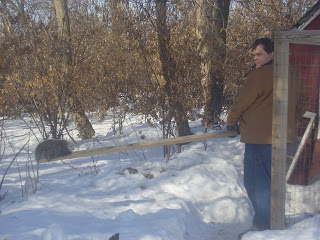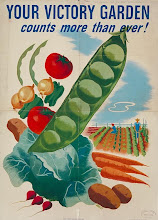Easy peasy lemon squeezy! All you need is cream, a blender, a small strainer or collander, and some cheese cloth. Actually, I start out with whole milk from a nearby dairy. Let it sit undisturbed in the fridge for at least eight hours, til the cream rises to the top.
 (photo credit: 'Janene' from Keeping a Family Cow online forum)
(photo credit: 'Janene' from Keeping a Family Cow online forum)
In the picture above, you can see the cream lines in the different jars. The cream is the more 'solid' creamy-colored (makes sense) stuff floating on top of the more blue-ish skim milk on the bottom. The farthest jar has the most cream - nearly 1/3 of the jar. If you have homogonized milk, the cream will never rise. The history of homogonization is a whole other story, and I won't get into it here. I've read that goat milk is naturally homogonized, which is why you never see goats-milk butter.
If you are letting the cream rise, make sure you put your milk in a wide-mouth container. Wide enough to fit your ladel into, and then some. That's how I skim my cream - with a ladel. It takes a bit of patience and a steady hand. You can skim off all of the cream, which will leave you with skim milk to drink. Or you can leave a little bit of the cream behind, which will give you 1-2% milk. Whatever you want. If you do leave some cream in your milk, remember to shake the jug before you pour it into a drinking glass - because again, the cream likes to rise to the top.

Here I have about two quarts of cream (and probably some milk too - my ladeling isn't perfect), skimmed from four gallons of whole milk. Now, if you want 'sweet' cream, you can start churning right away, while the cream is still fresh. Or, you can let the cream culture a bit. Culturing means letting the cream sit until it starts to smell a little bit sour. You can let it culture in the fridge, which will take up to a week, or on the counter top, which may take just a day or so. Depends on the freshness and quality of the milk and the air temperature.
The pros for letting your cream culture are two-fold: the butter churns faster and you get more butter. The big con against letting it culture is the taste. It has a little bit of a sour flavor. Some people like the taste, some people don't. It's up to you. I let my cream culture, because I use my home-made butter for cooking and baking, so I don't taste the sourness. Try it both ways, and see what you think.
The longer you let the cream rise, the thicker it will get. I've had cream that I could lift off with a fork, it was so thick. This thick cream is great for whipping (as in, whipped cream).

Pour your cream into the blender. Fill it no more than half-full. Put the cap on, and turn on the blender to the lowest speed. The intention is to get the butterfat molecules smacking up against one another. The intention is NOT to whip air into the cream (again, whipped cream), which you will do if you mix it at the highest speed.

Here is the cream, mixing away. Actually, you don't even need a blender to do this. If you have a lot of time, patience and strong arm muscles you can put your cream into a mason jar or a clean milk jug and just shake. And shake, and shake, and shake. You should get butter in about 30-40 minutes, again depending on various factors mentioned above.

The cream will go through a couple of stages. First it will begin to thicken. Then it will thicken some more. It will begin to look like pudding, or a thick malted milkshake. You might begin to see a bubbly froth rise to the top of the cream when you turn off the blender. That's normal. Keep churning.
Turn off the blender and check your cream every minute or two. Don't leave for twenty minutes to hang up the laundry - there is a danger of over-churning. That means churning through all the stages, including the butter stage, and then churning the butter into a gloopy mush. I've never done it, but then I've been pretty watchful.
If you're not bored to tears yet, look at my next post for part two of Making Butter.
P.S. Visit the Keeping a Family Cow website for lots of good homesteading info here:
http://www.real-food.com













 Jack Frost artwork.
Jack Frost artwork.















 Pour your cream into the blender. Fill it no more than half-full. Put the cap on, and turn on the blender to the lowest speed. The intention is to get the butterfat molecules smacking up against one another. The intention is NOT to whip air into the cream (again, whipped cream), which you will do if you mix it at the highest speed.
Pour your cream into the blender. Fill it no more than half-full. Put the cap on, and turn on the blender to the lowest speed. The intention is to get the butterfat molecules smacking up against one another. The intention is NOT to whip air into the cream (again, whipped cream), which you will do if you mix it at the highest speed. Here is the cream, mixing away. Actually, you don't even need a blender to do this. If you have a lot of time, patience and strong arm muscles you can put your cream into a mason jar or a clean milk jug and just shake. And shake, and shake, and shake. You should get butter in about 30-40 minutes, again depending on various factors mentioned above.
Here is the cream, mixing away. Actually, you don't even need a blender to do this. If you have a lot of time, patience and strong arm muscles you can put your cream into a mason jar or a clean milk jug and just shake. And shake, and shake, and shake. You should get butter in about 30-40 minutes, again depending on various factors mentioned above. The cream will go through a couple of stages. First it will begin to thicken. Then it will thicken some more. It will begin to look like pudding, or a thick malted milkshake. You might begin to see a bubbly froth rise to the top of the cream when you turn off the blender. That's normal. Keep churning.
The cream will go through a couple of stages. First it will begin to thicken. Then it will thicken some more. It will begin to look like pudding, or a thick malted milkshake. You might begin to see a bubbly froth rise to the top of the cream when you turn off the blender. That's normal. Keep churning.





